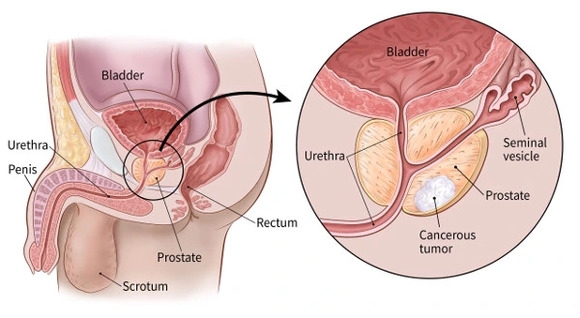Have a Longer Life Without Prostate Cancer

Prostate cancer is the fifth most prevalent malignancy in Indonesian males. In 2020, 13,563 new cases were reported. Recognize this cancer and raise awareness.
What is prostate?
The prostate is a tiny gland in men that resembles a walnut. These glands generate seminal fluid, which nourishes and transports sperm.
The prostate gland is located beneath the bladder. Behind it are seminal vesicle glands, which create sperm. The urethra, a tube that transports urine and sperm out of the body through the penis, is located in the center of the prostate.

The prostate's size might expand with age. It is typically the size of a walnut in young men and grows larger as they age.
Cancer occurs when cells in the prostate gland proliferate uncontrollably.
Prostate cancer types
Adenocarcinoma is the most common kind of prostate cancer. Cancer that arises from glandular cells.
Small cell carcinoma, neuroendocrine tumor, transitional cell carcinoma, and sarcoma are other, less prevalent forms.
In certain circumstances, prostate cancer develops slowly. It is harmless because it is localized to the prostate gland. Others are aggressive and swiftly spread.
Symptoms and causes
Prostate cancer usually has no symptoms at first. However, if it progresses, the following signs may appear:
● urinary problems;
● reduced urine pressure during peeing;
● urine contains blood;
● semen contains blood;
● bone pain;
● sudden weight loss;
● erectile dysfunction.
It is not yet clear what causes prostate cancer. To date, doctors only know that the DNA initiates the growth of abnormal cells.
Early detection of prostate cancer—when the cancer is still limited to the prostate gland—has the best chance of successful treatment.
Tumors occur when abnormal cells accumulate and spread to surrounding tissue. Some cancerous cells can also spread (metastasize) to other regions of the body.
Risk factors

Among the risk factors that increase the likelihood of prostate cancer are:
- Age
The risk grows with age. Prostate cancer usually emerges after the age of 50. - Race
According to data, blacks are more likely than other races to have prostate cancer. The reason is currently unknown. - Family history
Having a biological family member with prostate or breast cancer increases the risk. - Obesity
Excess weight raises the risk of cancer and makes it more aggressive and difficult to treat.
The factors listed above appear unavoidable. However, prostate cancer can still be prevented by leading a healthy lifestyle, eating nutritious foods daily, and exercising regularly.
Examination and diagnosis

If you have any complaints, have yourself checked out right away. A digital rectal examination, serum PSA (prostate-specific antigen), and transrectal or transabdominal ultrasound may be performed as part of the main examinations.
The results of a prostate biopsy or surgical specimen in the form of adenocarcinoma will provide a definitive diagnosis. Histopathological tests can also be used to assess the spread of abnormal cells.
Get screened to expedite treatment. Screening will also help to avoid complications such as:
- Cancer spreads (metastasis)
Prostate cancer can spread to other organs, such as the bladder. Or enter the circulation or lymphatic system to reach bones and other distant organs. - Incontinence
Prostate cancer and its treatment might result in incontinence or uncontrolled urine. Medication, catheters, and surgery are all options for treating this issue. - Erectile dysfunction (ED)
Prostate cancer and its treatments, such as surgery, radiation, or hormone therapy, can both induce this illness. Medication and surgery can help with erectile dysfunction.



